Navigation
The Scuba Doctor dive shop has an excellent range of quality drawstring bags for easy carrying of articles to the surface, or keeping your kit together.
Auckland
![]() Wreck Dive |
Wreck Dive | ![]() Boat access
Boat access
![]()
![]()
![]()
Two-Masted Iron Screw Steamer | Max Depth: 15 m (49 ft)
Level: Open Water and beyond.
The Auckland shipwreck (aka S.S. Auckland) is located off the north-west side of the exposed section of Beware Reef, near Cape Conran, East Gippsland. The wreck of the Auckland is a stunning dive dominated by the large numbers and varieties of marine species.
The Beware Reef protects the wreck in small south-east swells. The most suitable winds for diving this wreck are north-east to south-east. The recommended anchorage is in about 14m of water, close to the exposed reef at the northern end of the wreckage.
Diving the Auckland Shipwreck
From the anchor point at the northern end of the wreckage, head south down a gutter for a short distance, then head west over the edge of a drop off where you will find the bow section. Continue south to the engine and head up into shallower water then north back to the anchor.
Bass Strait Warning: Always keep an eye on sea conditions throughout any shore or boat dive in Bass Strait on Victoria's coastline. Please read the warnings on the web page diving-in-bass-strait before diving or snorkelling this site.
Auckland Shipwreck History — Built in 1863
The Auckland was a two-masted, iron screw steamer of 699 tons built in 1863 at Low Walker on Tyne, Newcastle, UK, by C. Mitchell & Co., on the dimensions of 212 ft. in length, a breadth of 28 ft. and a depth of 16 ft. 3 in. The steamer was initially fitted with a simple two cylinder, low pressure steam engine when sold to the Australasian Steam Navigation Co. in 1869.
After being transferred to its new owner the Auckland underwent a major refit, extending the quarterdeck to the bridge to enlarge the passenger accommodation. The engine was also compounded to run at a higher pressure, the first time this modification had been undertaken in Australia.
Auckland Sinking — 27 May 1871
On its first trip after this refit, the Auckland was returning to Sydney from Melbourne with 50 tons of iron, 500 bags of potatoes and 20 passengers, under the command of Captain Walker. On the night of the 27 May 1871, in thick weather with poor visibility, breakers were seen ahead looming out of the darkness. An attempt was made to reverse the engines but without effect and the Auckland crashed to a halt on Beware Reef, a few miles to the south-east of Cape Conran.
The fore hold had been breached with the impact and was flooded, so the crew attempted to shift some cargo to the stern, to try to get the vessel to back off the reef but to no avail.
Sometime later another steamer was seen astern and blue lights and rockets were fired to draw its attention and the S.S. Macedon which successfully removed all passengers and crew and most of the mails from the stricken steamer. A short time later the steamer Queensland with Captain Walker and some of the Auckland's crew returned to the site of the wreck to see what could be recovered. They reported that the vessel lay submerged in deep water with only the top of its masts still visible.
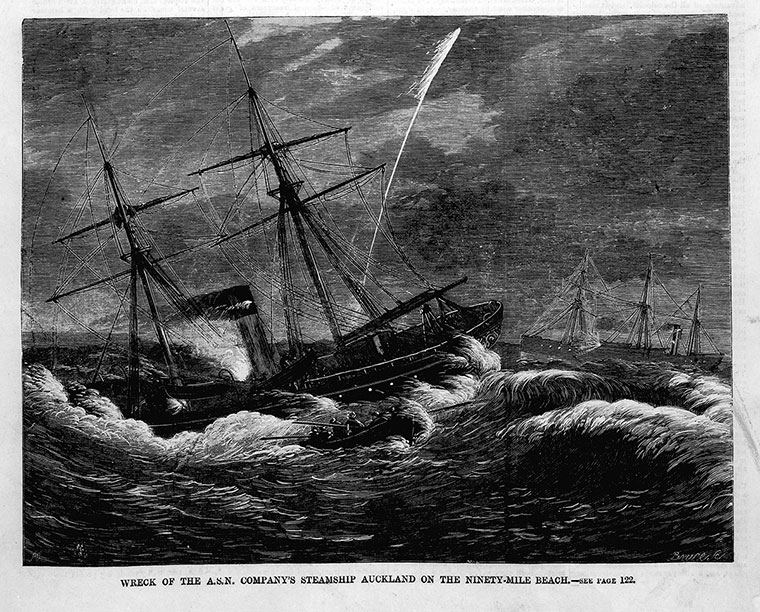
Wreck of the A.S.N. Company's Steamship Auckland on the Ninety-mile Beach.
Creator: Robert Bruce, engraver. Date: 17 June 1871.
Shows the S.S. Auckland with fire burning on board and the S.S. Macedon close by attempting to save the passengers.
The result of the subsequent official inquiry into the loss of the Auckland, found that after the recent repairs and modifications the owner's had neglected to check the compasses which it was believed were made unreliable and as a result of this over-sight, Captain Walker was found not to be accountable for the Auckland's loss
See also, Heritage Council Victoria: S.S. Auckland.
Heritage Warning: Any shipwreck or shipwreck relic that is 75 years or older is protected by legislation. Other items of maritime heritage 75 years or older are also protected by legislation. Activities such as digging for bottles, coins or other artefacts that involve the disturbance of archaeological sites may be in breach of the legislation, and penalties may apply. The legislation requires the mandatory reporting to Heritage Victoria as soon as practicable of any archaeological site that is identified. See Maritime heritage. Anyone with information about looting or stolen artefacts should call Heritage Victoria on (03) 7022 6390, or send an email to heritage.victoria@delwp.vic.gov.au.
Beware Reef Marine Sanctuary
This dive site lies in the Beware Reef Marine Sanctuary which is a challenging place to dive, please take care.
Beware Reef Marine Sanctuary encompasses a series of pinnacles of granite rock rising 30 metres off the sea floor, with only a small section at its northern extremity rising some two metres above sea level. This underwater mountain range runs for just over one kilometre to the south-east from the drying part of the reef, and the marine sanctuary that protects this unique reef covers an area of 220 hectares. The reef lies five kilometres to the south-east of Cape Conran and about three kilometres offshore from the beach at Yeerung River.
Dive Sites
Dive sites at Beware Reef Marine Sanctuary include:
- Beware Reef
- Seal Gully
- The Southern Pinnacle
- S.S. Auckland shipwreck — wrecked in 1871
- Ridge Park shipwreck — wrecked in 1881
- Albert San (aka SS Brolga) steam trawler shipwreck — wrecked in 1926
There are many other great sites for the inquisitive diver to explore here.
Boat Launch
There is a boat ramp at West Cape, Cape Conran which is suitable for most vessels up to six metres and a 4WD is normally required for launch and retrieval. The ramp can be inundated with sand and kelp for short periods of time. Due to the shallow angle of the ramp, low tides can be difficult to launch and retrieve vessels.
The boat launch site is exposed to westerly/ south-westerly winds and ocean swells. Calm sea conditions with light northerly winds and higher tides is ideal.
From the boat ramp at West Cape, avoid 'prop rock' which is about 50 metres directly out from the ramp and very shallow at low tide, and head south until you round the cape. Once clear of the cape head in an easterly direction for about 4 kilometres. The exposed section of Beware Reef is visible on a clear day once you clear the tip of Cape Conran. Often whitewater can be seen breaking on the exposed reef before the bare rock itself is sighted.
Beware Reef Marine Sanctuary Boundaries
NW corner of sanctuary
Latitude: 37° 48.883′ S (37.81472222° S / 37° 48′ 53″ S)
Longitude: 148° 46.700′ E (148.77833333° E / 148° 46′ 42″ E)
NE corner of sanctuary
Latitude: 37° 48.867′ S (37.81444444° S / 37° 48′ 52″ S)
Longitude: 148° 47.717′ E (148.79527778° E / 148° 47′ 43″ E)
SW corner of sanctuary
Latitude: 37° 49.683′ S (37.82805556° S / 37° 49′ 41″ S)
Longitude: 148° 46.717′ E (148.77861111° E / 148° 46′ 43″ E)
SE corner of sanctuary
Latitude: 37° 49.667′ S (37.82777778° S / 37° 49′ 40″ S)
Longitude: 148° 47.733′ E (148.79555556° E / 148° 47′ 44″ E)
See also, Parks Victoria: Beware Reef Marine Sanctuary,
Park Note: Beware Reef Marine Sanctuary,
Facebook: Friends of Beware Reef Marine Sanctuary,
Beware Reef Marine Sanctuary Divers Guide, and
Beware Reef Marine Sanctuary Identification Booklet Third Edition.
You are not permitted to carry a spear gun while snorkelling or scuba diving in Beware Reef Marine Sanctuary.
Traditional Owners — This dive site does not lie in the acknowledged traditional Country of any first peoples of Australia.
Auckland Location Map
Latitude: 37° 49.160′ S (37.819333° S / 37° 49′ 9.6″ S)
Longitude: 148° 47.043′ E (148.78405° E / 148° 47′ 2.58″ E)
Datum: WGS84 |
Google Map
Added: 2021-01-29 06:52:25 GMT, Last updated: 2022-05-03 22:07:40 GMT
Source: Beware Reef Marine Sanctuary Divers Guide
Nearest Neighbour: Ridge Park, 126 m, bearing 4°, N
Iron Screw Steamer, 699 ton.
Built: Newcastle, UK, 1863.
Sunk: 27 May 1871.
Beware Reef Marine Sanctuary, East Gippsland.
Depth: 15 m.
[ Top ]
DISCLAIMER: No claim is made by The Scuba Doctor as to the accuracy of the dive site coordinates listed here. Should anyone decide to use these GPS marks to locate and dive on a site, they do so entirely at their own risk. Always verify against other sources.
The marks come from numerous sources including commercial operators, independent dive clubs, reference works, and active divers. Some are known to be accurate, while others may not be. Some GPS marks may even have come from maps using the AGD66 datum, and thus may need be converted to the WGS84 datum. To distinguish between the possible accuracy of the dive site marks, we've tried to give each mark a source of GPS, Google Earth, or unknown.
Copyright © 2005-2022 by The Scuba Doctor Australia, ABN 88 116 755 170. All rights reserved.
tel. +61 3 5985 1700 :: email. diveshop@scubadoctor.com.au :: Web site by it'sTechnical 2022

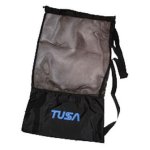
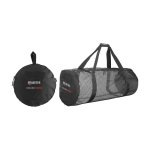
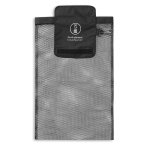
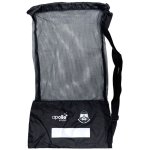
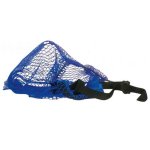
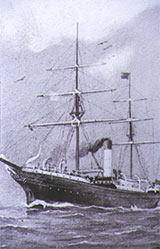
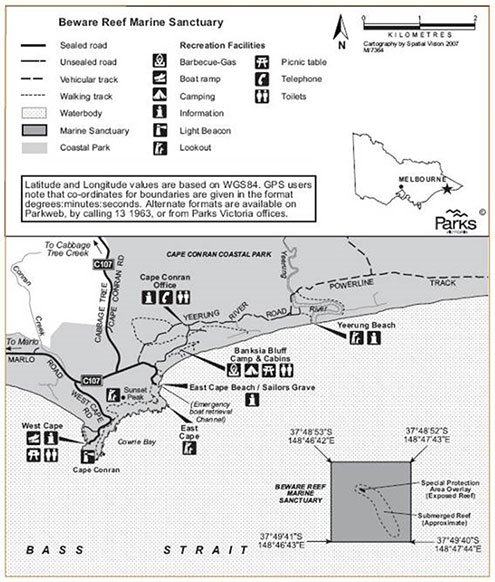


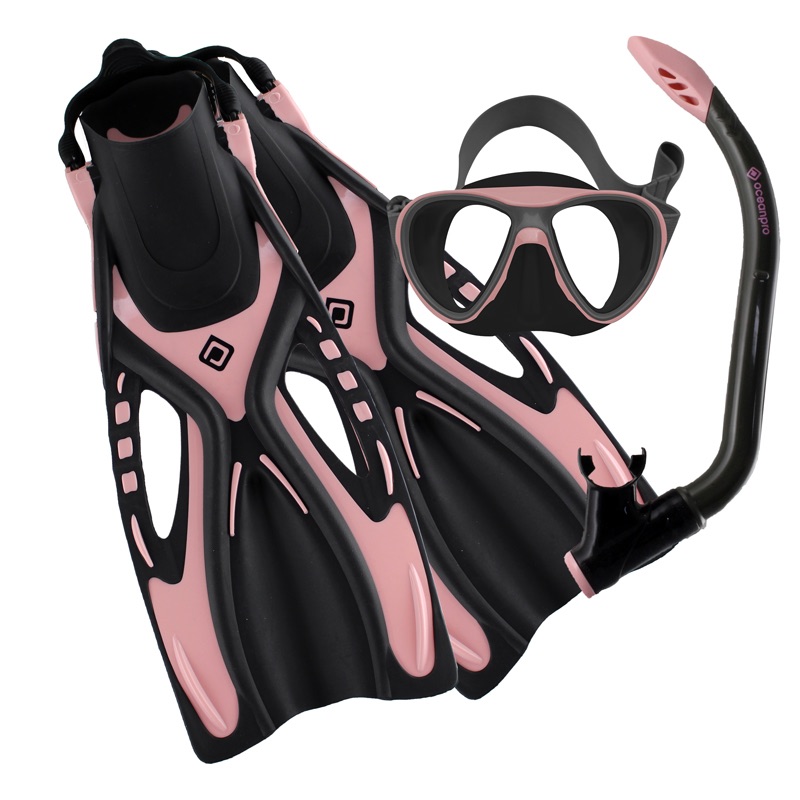





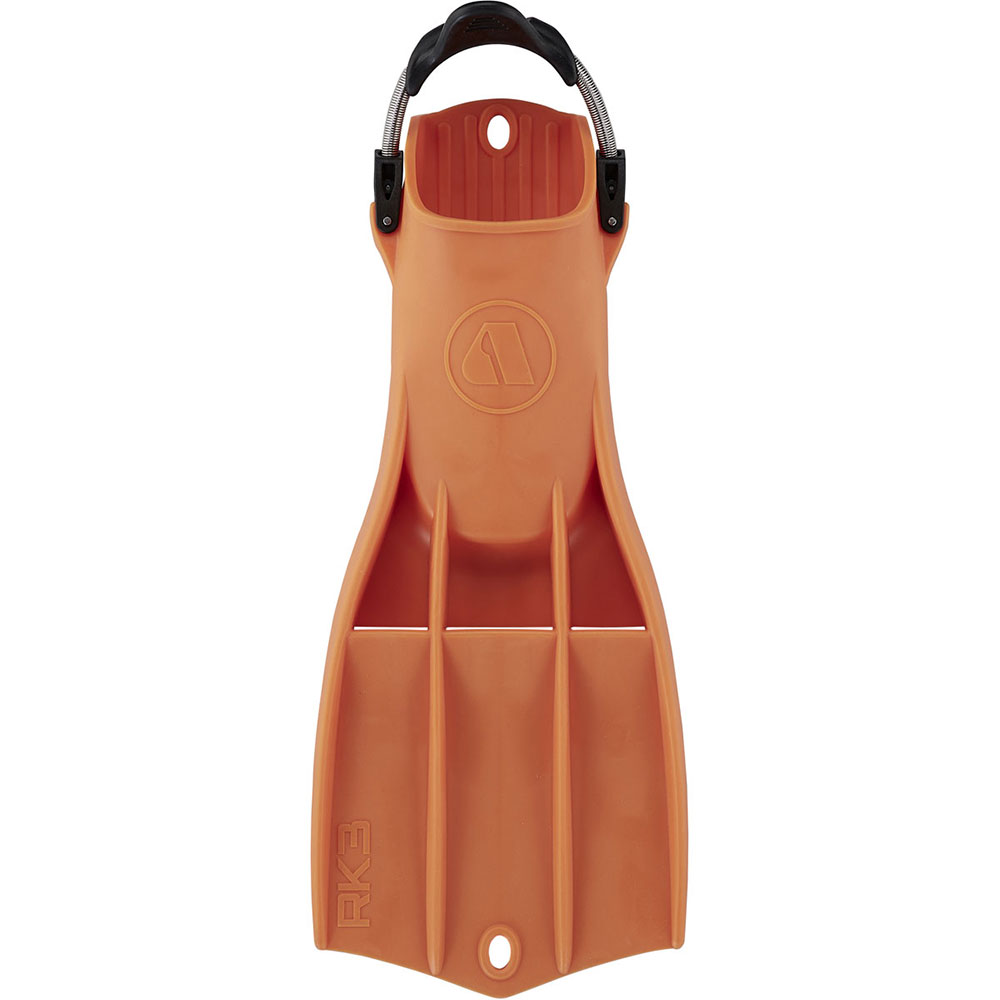


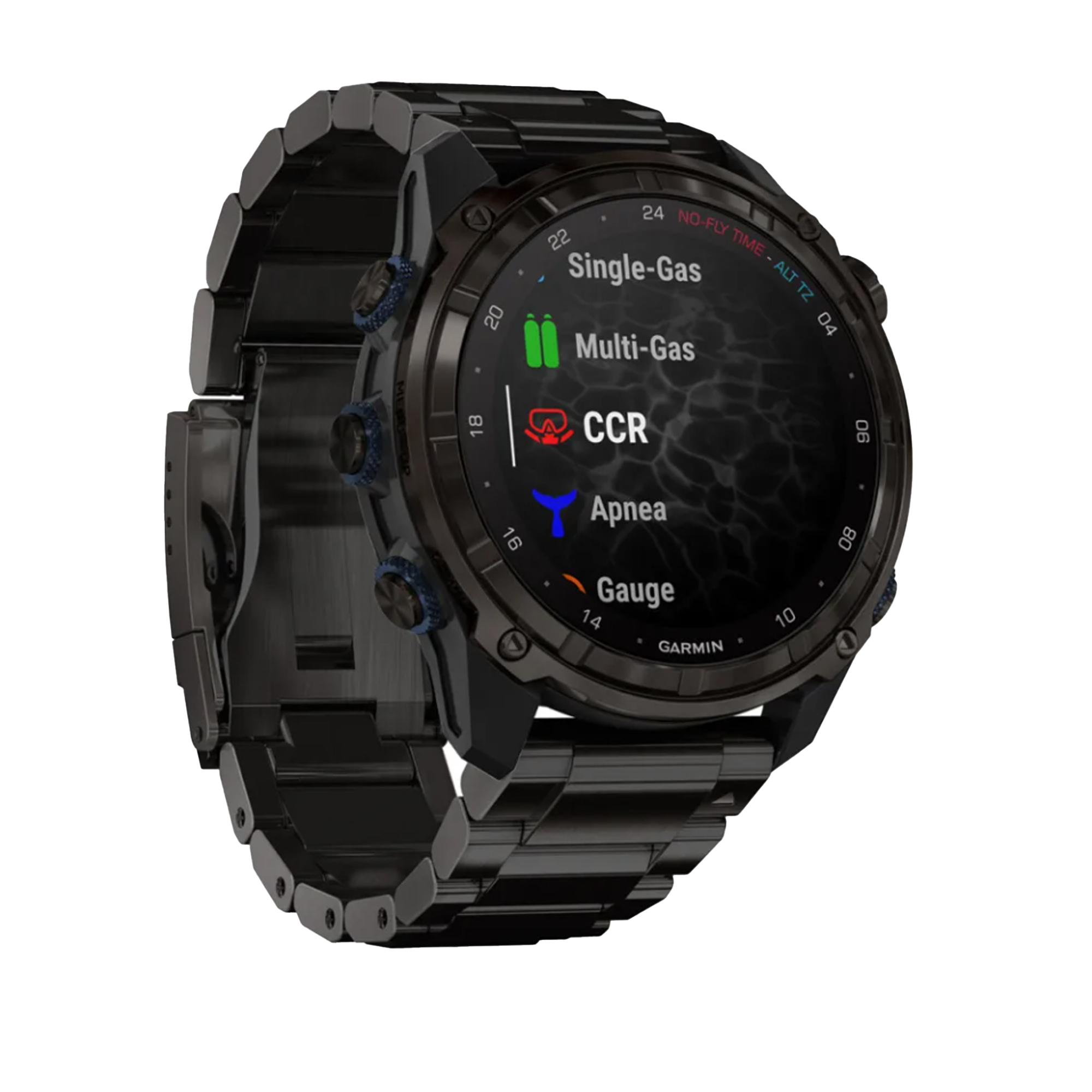





![Halcyon Infinity 30lb System [SS Small Backplate] Halcyon Infinity 30lb System [SS Small Backplate]](/diveshop/images/halcyon/Halcyon-Evolve-Wing.jpg)















































































































